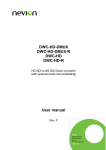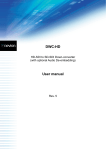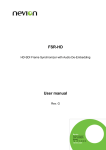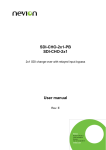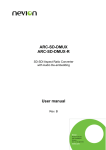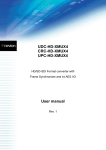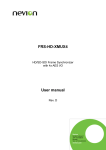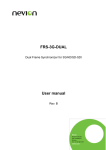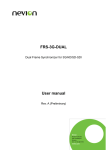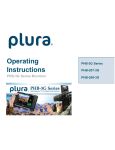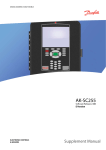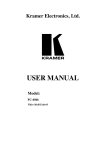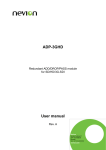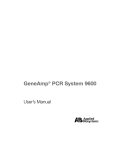Download FRS-HD-CHO / FRS-HD-CHO-ASI / ASI-CHO-2x1
Transcript
FRS-HD-CHO / FRS-HD-CHO-ASI / ASI-CHO-2x1-PB HD/SD-SDI 2x1 Change-Over with Frame Synchronizer and/or ASI 2x1 Change-Over User manual Rev. K Nevion Nordre Kullerød 1 3241 Sandefjord Norway Tel: +47 33 48 99 99 nevion.com FRS-HD-CHO Rev. K Nevion Support Nevion Europe Nevion USA P.O. Box 1020 3204 Sandefjord, Norway Support phone 1: +47 33 48 99 97 Support phone 2: +47 90 60 99 99 1600 Emerson Avenue Oxnard, CA 93033, USA Toll free North America: (866) 515-0811 Outside North America: +1 (805) 2478560 E-mail: [email protected] See http://www.nevion.com/support/ for service hours for customer support globally. Revision history Current revision of this document is the uppermost in the table below. Rev. Repl. Date Sign K 9 2015-05-14 MB 9 8 2012-08-10 TB 8 7 2012-05-04 TB 7 6 2012-02-22 TB 6 5 2011-08-15 TB 5 4 2011-05-19 TB 4 3 2010-02-24 TB 3 2 2009-05-12 RS 2 1 2009-05-06 SHH 1 0 2009-03-03 SHH 0 B A B A - 2008-12-15 2008-12-04 2008-10-17 NBS SHH SHH Change description Cover page update; DoC removed; no other changes to content Corrected DIP switch description for ASI-CHO2x1. Added min/max audio delay. Corrected table 2, Connections. Added description of the GPIO mode selector under GPI alarms. Added the ASI-only variant, ASI-CHO-2x1-PB. Updated several screen-shots to current look (Multicon 3.6.0) Added clarification about –ASI upgrade and HW versions. Added description for the ASI variant. Some changes to DIPs and the list of commands. Added Declaration of Conformity. Added APVF and silence trigger (ch.5.2), updated block diagram (ch.1.1), replaced ‘kill’ with ‘mute’ as audio fallback (ch.5.13), replaced misleading figures on sync (ch.5.4.1). Corrected cable equalization spec on inputs Added a requirement of termination of unused SDI-inputs/outputs in chapter 3.3. Updated document with Label generator and corrected an error in the mtx 0 description First release of product. Re-written and new Gyda features included. Initial release. nevion.com | 2 FRS-HD-CHO Rev. K Contents 1 Product overview .................................................................................................................4 1.1 Product description ...........................................................................................................4 2 Specifications ......................................................................................................................6 3 Configuration .......................................................................................................................8 3.1 Manual mode ...................................................................................................................8 3.2 Gyda mode..................................................................................................................... 10 3.3 Connections ................................................................................................................... 12 3.4 Sync input ...................................................................................................................... 12 4 Operation .......................................................................................................................... 13 4.1 Front panel LED indicators ............................................................................................. 13 4.2 GPI alarms ..................................................................................................................... 13 5 Functional description ....................................................................................................... 15 5.1 Selection of input signal type (FRS-HD-CHO-ASI only) .................................................. 15 5.2 SDI data path ................................................................................................................. 15 5.3 Video input selection ...................................................................................................... 15 5.4 De-glitcher ...................................................................................................................... 18 5.5 Frame synchronizer ........................................................................................................ 19 5.6 Video generator .............................................................................................................. 23 5.7 Label generator .............................................................................................................. 24 5.8 Video processing block................................................................................................... 24 5.9 EDH processing block .................................................................................................... 25 5.10 Video output selection .................................................................................................. 25 5.11 Audio blocks overview .................................................................................................. 25 5.12 Audio de-embedder ...................................................................................................... 26 5.13 Audio delay .................................................................................................................. 26 5.14 Audio cross point matrix ............................................................................................... 27 5.15 Audio generator ............................................................................................................ 27 5.16 Audio processing block................................................................................................. 27 5.17 Audio embedder ........................................................................................................... 28 6 RS422 commands ............................................................................................................. 29 6.1 FLP4.0 required commands ........................................................................................... 29 6.2 Normal control blocks ..................................................................................................... 30 6.3 Commands intended for debug/lab use only ................................................................... 35 General environmental requirements for Nevion equipment ................................................. 36 Product Warranty ................................................................................................................. 37 Appendix A Materials declaration and recycling information ................................................. 38 nevion.com | 3 FRS-HD-CHO Rev. K 1 Product overview Figure 1: Simplified block diagram of the FRS-HD-CHO card 1.1 Product description The base version of the Flashlink FRS-HD-CHO is a 2x1 HD/SD change-over module with a frame synchronizer that can lock an HD-SDI or SD-SDI input to a black & burst or tri-level reference signal. A de-glitcher ensures an always error-free output. The change-over functionality covers numerous switching criteria that analyses video and audio integrity and content. The switching criteria are placed into several logical groups, each of which can have their own timing. The FRS-HD-CHO has an extensive audio functionality, including audio cross point matrix, channel swapping, relative audio delay, and audio gain. The module is also well suited for Dolby-E. An extension - and even a separate version - exists that will also handle change-over switching on ASI inputs, but then without the frame synchronizer, de-glitcher, and audio functionality. The user parameters of the card can either be changed by switches on the board, or by the Multicon Gyda system controller. 1.1.1 Product versions This product comes in three versions: The base model FRS-HD-CHO for HD/SD-SDI, the FRS-HD-CHO-ASI with a selectable SDI or ASI mode, and an ASI-only version called ASI-CHO-2x1-PB. The ASI-CHO-2x1-PB is not designed to be upgradable to an FRS-HD-CHO or an FRS-HD-CHO-ASI. The user interface for ASI-only is however much reduced compared to the SDI capable versions with frame synchronizer and audio embedding/de-embedding, making the ASI-CHO-2x1-PB very easy to understand, set up, and use. Some FRS-HD-CHO modules can be upgraded to FRS-HD-CHO-ASI with a software key (for a nominal fee). These modules can be recognized by the way they respond to a ‘?’ command on the serial communication bus, and the way they present themselves in the Multicon Gyda configuration page. If the reply to the ‘?’ command contains a line that says “Serial rev 1728201000000001” (the actual 16-digit number will be different) and a line that says “HW rev 1.1”, or there are two lines at the very bottom of the Multicon configuration page that looks like below, the module can be upgraded to the ASI version with a software key: nevion.com | 4 FRS-HD-CHO Rev. K If one (or both) of these two lines is not present, or the HW version is reported as 1.0, or the serial number reported is “XXXXXXXXXXXXXXXX” (literally sixteen X characters), the module cannot be field upgraded from the FRS-HD-CHO to the FRSHD-CHO-ASI version. Of course, the module can still be upgraded with the latest firmware and continue to work as an FRS-HD-CHO. 1.1.2 Key features Passive bypass from both inputs to non-inverted outputs with less than 25m loss of cable length (enables full redundancy, see app. note in appendix) HD/SD video support, including DVB-ASI in through mode Separate ASI mode available (as an upgrade from the ‘normal’ FRS-HD-CHO) Separate ASI-only version available with a much simplified user interface De-glitching of input video signal (always seamless output) Intelligent change-over functionality with switching criteria: Video integrity check Audio integrity check Video freeze detect (full frame or active area) Video black detect (with adjustable black threshold) Time code freeze Audio silence detect (with adjustable silence threshold) Latched switching Ripple rejection latching with adjustable hold times Switching between inputs on switching line GPI inputs for external control of switch Individual detection timings for video signal integrity, audio signal integrity, video content and audio content. HD/SD frame sync/delay (8 frames max) luma/chroma gain and level adjustment Audio delay enabling Dolby-E processing delay correction Audio router for embedded audio Embedded audio gain adjustment Audio fade out/fade in at switching or frame-wrap SDI Label inserter EDH processing nevion.com | 5 FRS-HD-CHO Rev. K 2 Specifications Electrical SDI input Number of inputs 2 Connectors Equalization 75 Ohm BNC Automatic; >300m @270Mbps w/Belden 8281, with BER < 10E-12 >130m @1485Mbps w/Belden 1694A, with BER < 10E-12 >15dB, 5MHz -1.485GHz Input Return loss Active input Input Return loss passive bypass Jitter tolerance >15dB, 5MHz -742.5MHz >10dB, 742.5MHz - 1.485GHz SD limit: 10Hz-1kHz: >1 UI 10kHz – 5MHz: >0.2 UI HD limit: 10Hz-100kHz: >1 UI 100kHz–10MHz: >0.2 UI Electrical Sync input Connector Format Input Return loss 75 Ohm BNC Black & Burst, Tri-level >35dB @ < 10MHz, 30dB @ < 30MHz Electrical SDI outputs Number of outputs Connectors Return Loss O1, O2 Active output Output Return loss O1, O2 Passive bypass Return loss !O1, !O2 Output signal level Output signal rise / fall time 20% - 80% Amplitude overshoot Output timing jitter Output alignment jitter 4 75 Ohm BNC >15dB, 5MHz -1.485GHz >15dB, 5MHz -742.5MHz >10dB, 742.5MHz - 1.485GHz >15dB, 5MHz -742.5MHz >10dB, 742.5MHz - 1.485GHz 800mV +/- 10% SD limit: [0.4ns – 1.5ns]; <0.5ns rise/fall var. HD limit: < 270ps, <100ps rise/fall var. <10% SD: <0.2 UI HD: <1 UI SD: <0.15 UI HD: <0.2 UI nevion.com | 6 FRS-HD-CHO Rev. K Supported standards SD, 270 Mbps HD, 1485 Mbps DVB-ASI1 Video switch point definition and sync EDH Video Payload Identification Other Power consumption 1 SMPTE 259M, SMPTE 272M-AC SMPTE 292M, SMPTE 274M, SMPTE 291M, SMPTE 296M, SMPTE 299M 50083-9, error detection according to ETR290 1.1 and 1.2 SMPTE RP168 (tri-level), SMPTE 170m, ITU-R. BT.470 Compliant to SMPTE-RP165 SMPTE 352M-2002 3.5W @ 5V 1.2W @ 15V The ASI support can be purchased as an optional upgrade. nevion.com | 7 FRS-HD-CHO Rev. K 3 Configuration The board can be configured both manually and through the system controller Multicon Gyda. However, only a few of the configurable parameters are available when operating in manual mode. 3.1 Manual mode To reach manual mode DIP16, labeled OVR, on the board must be switched on (to the right) and the board must be re-booted. This takes the board out of Multicon Gyda control (if it was previously set to off) and a number of the module’s features will be controlled directly by the other DIP switches, the rotary switch, and the two pushbuttons. Settings not controlled by any of these switches are kept unchanged from previous session (factory setup or Gyda setup). The Manual Mode configuration controls are all found on the front side of the board. There are two sets of DIP switches, one rotary switch and two push buttons. The slide switch on the lower right is used to select sync source for both modes of operation, see 3.1.2 below. Figure 2: The figure shows a top view component printout of the board. LEDs, pushbuttons, the rotary switch and the 2 sets of DIP-switches are colorized. 3.1.1 Rotary switch and push buttons The rotary switch, labeled DLY, adjusts the phase delay by -5 to +4 video lines. It is only functional when a sync signal, black & burst or tri-level, is present at the sync input. The rotary switch is accessible from the front of the rack. The push buttons, labeled INC and DEC, are used to fine adjust the phase delay by samples. It can adjust within +/- ½ video line for the video standard seen by the module. 3.1.2 Slide switch The slide switch on the lower right side of the card selects between backplane sync input (BP) and Flashlink rack distributed sync (RACK). The rack distributed sync is a future feature upgrade of the Flashlink frame, and at present the switch should always be set to its lower position (to BP). 3.1.3 Factory reset function The factory reset function restores the module to its default settings. These settings are just a start condition for the board, and changes done by the user will still take effect and be stored. nevion.com | 8 FRS-HD-CHO Rev. K The factory reset is initiated by setting DIPs 15 and 16 to the ‘On’ position and booting the module. All inputs signals should be removed. The status LED will stay permanently orange, and the module will not complete its start-up. DIP 15 should then be returned to the ‘Off’ position, while DIP 16 should be set to the desired mode of operation before the module is booted again. This starts the actual internal reset process, and the module should now be left powered for at least 10 seconds or the complete set of default setting may not be stored properly. If necessary, the reset operation can be performed multiple times. 3.1.4 DIP switch functions The two sets of DIP switches are labeled with a number running from 1 to 15. The 16 th DIP is labeled OVR. Note that the left DIP switch of the horizontal DIP package is number 1. The top DIP switch of the vertical DIP package is number 9. Switch # Function name Function DIPs 1 ASI/SDI input mode (FRS-HD-CHOASI only) Off: input is SDI On: input is ASI (For valid ASI output, DIP12 and/or DIP13 must also be set to the ‘Through position’) 2 CHO priority Off = In1 On = In2 3 --- Reserved 4-5 Lock & Hold time 6 Audio gen Off = 1kHz Sine On = Black sound 7 Emb. enable Off: No audio embedded On: Audio embedded When off, the audio is left untouched on the SDI stream. When on, the audio configured to be embedded is embedded into the SDI. 8 GPIO setup Off: SDI-CHO-2x1 mode On: FRS-HD-SDI mode See the GPI input output description below. 9 - 11 Frame delay DIP[9 10 11] = [Off Off Off] => 0 frms DIP[9 10 11] = [Off Off On] => 1 frms DIP[9 10 11] = [Off On Off] => 2 frms DIP[9 10 11] = [Off On On] => 3 frms DIP[9 10 11] = [On Off Off] => 4 frms DIP[9 10 11] = [On Off On] => 5 frms DIP[9 10 11] = [On On Off] => 6 frms DIP[9 10 11] = [On On On] => 7 frms DIP[5 6] = [Off Off] => Minimum DIP[5 6] = [Off On] => 1s DIP[5 6] = [On Off] => 4s DIP[5 6] = [On On] => Reserved Comment FRS-HD-CHO-ASI only. Note: Firmware older than ver. 1.10 use this DIP for a latch on/off input setting. Note: Firmware older than ver. 1.10 use this DIP for selection between Loss Of Signal and Loss Of Lock. Only valid if latch is on With a sync-input present, this sets the minimum frames delay. Without a sync-input present this sets the no. of frames delay relative to the input. nevion.com | 9 FRS-HD-CHO Rev. K Switch # Function name Function DIPs Comment 12 SDI OUT 1 Off: through mode On: processed mode In through mode the video only goes through a re-clocker. 13 SDI OUT 2 Off: through mode On: processed mode In through mode the video only goes through a re-clocker. 14 Video Generator Off: Color bar On: Black field This is the video generator signal that is shown when video is detected lost according to the fallback rule set in GYDA. 15 RESET Off: Use values preset by GYDA. On: RESET to factory defaults To reset, both DIP 15 and DIP16 must be set on before powering on. DIP 15 and 16 is read at power up. The reset is not done until DIP 15 is set back to off and re-powered. 16 OVR Off: GYDA mode On: Manual mode This DIP is only read at power up. OVR is short term for GYDA override Table 1: DIP SWITCH FUNCTIONS For the ASI-CHO-2x1-PB, only DIPs number 2, 4, 5, and 8 (and 15+16) will have any effect. The rest will be ignored and can be set to any position. 3.2 Gyda mode All functions of the card can be controlled by the Multicon Gyda control system. In Multicon Gyda the module has an information page and a configuration page. 3.2.1 Information page The information page for ASI-CHO-2x1-PB is a subset of the information page for FRSHD-CHO, which in turn is a subset of the information page for FRS-HD-CHO-ASI. While the FRS-HD-CHO and FRS-HD-CHO-ASI only differ in that the latter has an extra line for “Input signal type”, the ASI-CHO-2x1-PB information page is quite reduced, because the frame synchronizer and audio embedder/d-embedder functionality quite simply isn’t included. The difference between Figure 3 and Figure 4 should make this clear. The following paragraphs will describe the information page for FRS-HD-CHO(-ASI), but as far the mentioned items are also present in the ASI-CHO2x1-PB information page, the description will apply for that product version as well. The information page shows a dynamic block-diagram of the board and some additional information in textual form. The block diagram updates with the boards status, showing input signal selected, signals missing (by red crosses over signal lines), and routing through switches. It also shows the audio matrix selections that have been made on the configuration page. Note that if embedded audio is missing from a group, the user will still be allowed to select those inputs in the matrix, but the output will go to a fallback position. Missing audio channels will be shown in the block diagram with a red cross over the matrix input line. The text on the information page gives information about functionality not displayed on the dynamic block diagram. The video delay represents the actual delay between input and output video. nevion.com | 10 FRS-HD-CHO Rev. K If the ASI option has been purchased, the name of the module will have ‘-ASI’ appended. In addition, a line ‘Input signal type’ followed by ‘SDI’ or ‘ASI’ will appear as a reminder of the selected mode, ASI or SDI. Figure 3: Gyda information page for FRS-HD-CHO-ASI Figure 4: Gyda information page for ASI-CHO-2x1-PB 3.2.2 Configuration page The different configuration possibilities are explained in detail in Chapter 5, under the corresponding functions. nevion.com | 11 FRS-HD-CHO Rev. K 3.3 Connections Figure 5: FRS-HD-CHO-C1 backplane right: connection side left: component side The backplane for the FRS-HD-CHO is labeled FRS-HD-CHO-C1. The table below shows the connectors and their functions. Function HD/SD-SDI or ASI input 1 HD/SD-SDI or ASI input 2 HD/SD-SDI or ASI output 1 HD/SD-SDI output 1, inverted (ASI is a polarized signal, i.e. the inverted signal is not valid ASI unless inverted a second time) HD/SD-SDI or ASI output 2 HD/SD-SDI output 2, inverted (ASI is a polarized signal, i.e. the inverted signal is not valid ASI unless inverted a second time) Black & Burst/ tri-level input Black & Burst/ tri-level input GPI in GPI out Label IN1 IN2 O1 ___ O1 O2 ___ O2 SYNC SYNC GPI GPI Connector type BNC BNC BNC BNC BNC BNC BNC BNC TP45, pin 5 & 6 TP45 pin 1, 2, 3, 4, 7 (pin 8 = GND) Table 2: Connector functions Unused SDI/ASI-inputs/outputs must be terminated with 75 Ohm. 3.4 Sync input The two sync inputs on the backplane are internally connected. It is possible to use one as input and the other as a looped output. The backplane also features a switchable termination. By setting the “red” switch in the upper right of Figure 5 to the ‘On’ position the sync input will be terminated to 75 Ohms. nevion.com | 12 FRS-HD-CHO Rev. K 4 Operation 4.1 Front panel LED indicators Diode \ state Card status Red LED PTC fuse has been triggered or FPGA programming has failed SDI input status Video signal absent. Sync input status Sync signal absent Audio input status No audio embedded in incoming video Orange LED Module has not been programmed, RESET and OVR DIPS are on or module is updating firmware. Video signal present but card not able to lock VCXO Sync signal present but card unable to lock VCXO One, two or three audio groups embedded in incoming video Green LED Module is OK No light Module has no power Video input signal in lock Module has not been programmed B&B or Trilevel sync in lock Module has not been programmed 4 audio groups embedded in incoming video Module has not been programmed A few special conditions exist for the LEDs: - When upgrading the module’s FPGA software there a transfer stage followed by an unpacking stage. During the unpacking the LEDs will display a running-lights pattern, three orange LEDs and one unlit LED. - When running a Locate command all four LEDs will flash slowly between orange and unlit. - When running the module in manual mode the two push buttons can be used to set the sample part of the phase delay. When the end of the adjustment range is reached, the closest LED will flicker briefly. Returning to 0 samples by pressing both push buttons simultaneously will be acknowledged by the two middle LEDs flickering briefly. 4.2 GPI alarms The FRS-HD-CHO can have the GPI outputs to be setup as “change-over style” or “frame sync style”, either by DIP8 or by Multicon Gyda control. In the graphical user interface of Multicon Gyda, the selector looks like this: The selection “FRS-HD-DMUX compatible” is equal to what the table on the next page refers to as “frame-synch style”, while “SDI-CHO-2x1 compatible” is equal to the “change-over style” of the GPIO lines. As the table on the next page shows, the difference lies in the behavior of pins 3, 4, and 7. nevion.com | 13 FRS-HD-CHO Rev. K 4.2.1 Functions of 8pin modular jack GPI name Function Pin Mode # ( change( change-over style / over style / frame-synch style ) framesynch style ) Status General error status Pin Inverted for the module. 1 Open Collector (open is alarm) 2 LOS Loss of signal or lock Pin Open at selected input 2 Collector Input 1/ Input 1 selected (IN1)/ Pin Open Sync loss 3 Collector Sync input loss of signal or lock Input 2/ Input 2 selected (IN2)/ Pin Open 2 4 Collector Framedelay Outputs a pulse with length equal to frame delay Reset Reset selected input Pin TTL, 0V = to main 5 active level Set Set selected input to Pin TTL, 0V = standby 6 active level Input 2/ Connected to pin 4 on Pin Open backplane 7 Collector Frame 3 delay Ground 0 volt pin Pin 0V. 8 Direction Output Output Output Output Input Input output 2 EDH errors will not be shown at GPI output. Pin 4 and 7 are connected on TP45 connector to be compatible with both FRS-HD-SDI and SDI-CHO-2x1. 3 nevion.com | 14 FRS-HD-CHO Rev. K 5 Functional description 5.1 Selection of input signal type (FRS-HD-CHO-ASI only) If the optional ASI upgrade has been purchased, the top of the configuration page will be a selector between SDI input mode and ASI input mode. In ASI mode, the module will not lock to a non-ASI SDI signal. The ASI signal will not pass through the FPGA, it will only be passed to the FPGA, enabling the FPGA to look for valid ASI data. In order to get an output in ASI mode, the video output must also be taken from the Pass-through position (see 5.10, Video output selection), meaning that the video output is re-clocked only. Figure 6: Gyda view of the input signal type selector 5.2 SDI data path HD/SD-SDI input is selected from input 1 or 2, equalized, re-clocked and transferred to a processing unit. Here the signal is first sent through a de-glitcher that cleans up errors that might appear on input signal, for instance due to switching. After the deglitcher the parallel video is split in two paths, one going directly to a frame-store buffer, the other sent to the audio de-embedder. The 16 audio channels coming from the de-embedder are bundled in pairs and sent to an audio store buffer (being the same as the frame store buffer). The audio is fetched from the audio store buffer according to a user specified delay and sent to an Audio Cross Point. The output of the Audio Cross Point can be any pair of audio channels deembedded from the incoming video stream, an internal 1 kHz sine or an internal “black sound”. “Black sound” is in function mute, but it produces a waveform pattern which is different from mute. Each channel pair from the cross point outputs enters an Audio Processing Block, where the paired channels may be level adjusted and shuffled. After the audio processing block the audio enters the Audio Embedder. The video (with audio still inserted) is fetched from the frame buffer with the user specified delay and sent to a Video processing block (gain, offset and hard clip legalizing), followed by an EDH processing block. After the EDH block the video and audio is embedded according to the user settings and the video is sent from the processing unit to a re-clocker. Here the signal is converted back to SDI and sent to a 2x2 output switch. The buffered output switch is a 2x2 cross point switching between an equalized and reclocked input (through) and a video processed input (processed). The two outputs are sent to two paired (non-inverting and inverting) outputs. 5.3 Video input selection The FRS-HD-CHO has two electrical inputs. The input can be chosen either by an automatic selection with priorities and rule of switching, or by manual selection. If there is a sync input connected, the board will switch the signals on the switching line of the present format. nevion.com | 15 FRS-HD-CHO Rev. K Manual selection mode Figure 7: Gyda view of input 1 selected in manual mode. Automatic selection mode Figure 8: Gyda view of the input selection If in Gyda the video in mode choice is set to auto, three input choices can be made for three priorities; electrical 1, electrical 2 or mute/generator4. When signal is missing on one priority, the change-over will switch to the next priority and look for signal. If only two priorities are needed, i.e. one main and a fallback, the third priority can be disabled by setting it to ‘–‘. Note that the ASI-CHO-2x1-PB product version does not have the Video gen. and Mute choices. Because no version of the FRS-HD-CHO has a built-in ASI generator, no fallback is available when using ASI input signals. This is also true for the FRS-HD-CHO-ASI; Even though the Video gen. and Mute choices are available regardless of the selected mode (SDI or ASI), no actual fallback will be available for lost ASI sources. Hold time and lock time controls how long a signal can be missing before the next priority is used, and how long a signal has to be present before it is considered to be OK again. This module is always latching, which means that is doesn’t switch from a fallback back to the main input unless it is either ordered to do so (the latch reset button), or if the fallback signal also disappears. Triggers In addition to the loss of signal and lock detect, there are a set of triggers that can force the switching to next priority. Equal types of triggers are grouped together in a trigger block. A trigger block consists of a switching enable signal, a trigger selection mask, a Boolean operator, a hold time and a threshold. The trigger block always report status of all triggers inside the trigger block. The switching enable signal (enable/disable radio button) enables the trigger to do a switch between the inputs after detecting a continuously present error over a hold time. The trigger selection mask selects which detections are enabled to do switching. The Boolean operator is either “and” or “or”. It controls whether the switching should be based on either (or) or all (and) of the selected triggers in the trigger selection mask. The trigger to switch time is the time that a trigger must be continuously present before a switching of the inputs will happen. 4 The processed video out block selects whether the output goes to mute or generator at loss of signal nevion.com | 16 FRS-HD-CHO Rev. K Level is number to set a threshold for a content check. The format of the levels will differ between trigger blocks. Not all trigger blocks have a threshold. The trigger blocks for the FRS-HD-CHO are: video error trigger block video content trigger block audio error trigger block 1 - 4 audio in silence trigger audio out clipping trigger active picture video freeze and silence trigger The different trigger blocks with their respective trigger masks are shown in Figure 9. Figure 9: The available triggers and their masks. nevion.com | 17 FRS-HD-CHO Term Description Video error trigger Rev. K Term Description Audio error trigger group 1 - 4 APV Active picture CRC invalid Ch 1 (2,3,4..) Channel 1 set inactive in audio control package FFV Full frame CRC invalid Group Audio group missing (in audio trigger 1,2,3,4, group = group 1,2,3,4) EDH EDH package missing (SD only) ACP Audio control package missing VSTD Video standard error U/O Audio underflow/ overflow ch. 1 - 4 FFCRC Full frame CRC error (SD only) BCH Audio CRC error APCRC Active picture CRC error (SD only) 48kHz Sampling rate different from 48kHz detected LOCK Loss of re-clocker lock CCS Chroma checksum error YCS Luma checksum error CCRC Chroma CRC (HD only) YCRC Luma CRC (HD only) LNUM Line numbering error (HD only) SAV Start of active video error EAV End of active video error Audio in silence trigger Ch1-2 (34..15-16) Audio level received in channel 1 and 2 below set silence threshold Audio out clipping trigger Ch1-2 (34..15-16) Audio out (after audio processing gain) is clipped. APVF and silence trigger Ch1-2 (34..15-16) Audio level received in channel 1 and 2 below set silence threshold while active picture video freeze is also detected Video content trigger VCLP Video clipping detected by legalizer FFVF Full frame video freeze detected APVF Active picture video freeze detected TCF Time code freeze detected BLK Black video detected (below set threshold) The black detect threshold is an integer between 0 and 255. Selecting a threshold of 10 will accept everything below 74 (04Ah) luma and between +10 and -10 (1F6h and 206h) chroma as black. The silence threshold can be adjusted in 6dB steps from -90dB to -18dB. ‘Audio in silence trigger’ and ‘APVF and silence trigger’ share the same silence threshold setting. It can only be adjusted from the ‘Audio in silence trigger’. The threshold value in ‘APVF and silence trigger’ will always display as 0 and the threshold value in ‘Audio in silence trigger’ is always the one used by the module. 5.4 De-glitcher The de-glitcher corrects timing errors within a line. The de-glitcher has a 2048 samples buffer. When the first signal is present, we call it the “initial phase signal”, data is taken from the centre of this buffer. If the timing reference of the video signal changes, when for instance a new source being switched into the signal path, the timing errors occurring by this change will be corrected if the new timing reference is within +/-1024 samples of the “initial phase signal”. This also goes for all consecutive timing references. nevion.com | 18 FRS-HD-CHO Rev. K If a signal is more than +/-1024 samples off relative to the “initial phase signal”, the output will repeat the last frame, refill the 2048 samples buffer and take out data from the centre of the buffer. This new signal is now considered the “initial phase signal”. Audio will fade out when a frame repeat is being done, and fade in at the new frame. Hence, it produces an error free video output without frame wrapping when the video input comes from a router with synchronous input video signals that all lies within +/1024 samples of each other. The de-glitcher output is always seamless. When a signal is repeated the audio is faded out. It fades in at the new frame. 5.5 Frame synchronizer The frame synchronizer consists of a frame store buffer and some control logic. The frame store buffer can store up to 8 full HD frames. Data is fetched from this buffer according to the user settings by force of the control logic. The control logic sets the frame synchronizer into different modes dependent on the presence of a sync input. 5.5.1 Frame sync mode If a sync input (B&B or Tri-level) is present, the frame synchronizer will output a signal that has a delay relative to this signal. Two parameters can be set; "Phase delay" and "Video delay". Figure 10: Gyda view of the video delay settings Let us first focus on the phase delay, which also may be called “output phase delay”. This parameter can be positive or negative, and determines the relationship between the outgoing video and the sync signal. The parameter really determines a delay on an internal sync signal, isync5. The output is synchronous with isync, see Figure 11. Figure 11: Positive phase delay Figure 11 show how the sync signal and the isync signal would look on an oscilloscope, if converted to analogue signals. The delay of isync can be given in frames, lines, and samples. The delay can be negative, see Figure 12. 5 Note that isync is not a physical entity, but a term used in this context to explain the delay process and the use of the configurable parameters related to this process. nevion.com | 19 FRS-HD-CHO Rev. K Figure 12: Negative phase delay The phase delay can thus be written in several ways, a large positive delay will equal a small negative delay, because there is wrap-around on a frame basis. It follows that it is not useful to specify a phase delay larger than 1 frame. Strictly speaking the range could have been limited to -1/2 frame to 1/2 frame. For convenience, the delay range is allowed to be from -1 frame + 1100 samples to 1 frame – 1100 samples. In order for FRS-HD-DMUX to honor the phase delay setting, it should ideally delay the incoming video between 0 to 1 frames. Because the processing delay through the card is 2 lines minimum, the actual window is between 2 lines and 1 frame + 2 lines. Hence, with the parameter (minimum) video delay set to 2 lines (the least number possible for the parameter); the output video will be between 2 lines and 1 frame + 2 lines delayed, with respect to the incoming video. A common occurrence in practical use is to synchronize an incoming video with a sync, but to let the outgoing video lead some samples or lines to the sync. This can easily be accomplished. Say that we want the outgoing video to occur 50 samples before the sync. We will then set the phase delay to -50 samples, and the video delay parameter to 2 lines. For convenience, let us assume that the incoming video is iso-synchronous, but that it lags 20 lines after the sync. We will then have the situation shown in Figure 13. Note that the numbers in circles in the next figures are visualizing the video frames. nevion.com | 20 FRS-HD-CHO Rev. K Figure 13: Example of delayed outgoing video To match larger processing delays, one will want to first delay the incoming video, and then synchronize the video. This is equivalent to introducing a delay line for the incoming video, and then synchronizing the output of the delay line to the sync. In effect, one moves the delay-window start; this is equivalent with setting of the video delay to a larger value. Let us assume that the video delay is set to 2 frames, 200 lines. In that case the outgoing video will be between 2 frames + 200 lines and 3 frames + 200 lines delayed with respect to the incoming video. For convenience, let us assume that the incoming video is iso-synchronous, but that it lags 25 lines after the sync. Let us also assume that the phase delay is set to -60 samples. We will then have the situation shown in Figure 14. Figure 14: Another example of delayed outgoing video nevion.com | 21 FRS-HD-CHO Rev. K To reiterate: The phase delay can be both positive and negative and sets the difference between the phase of the sync input and the video output. The video delay sets the delay between video output and video input. However, the actual delay might be longer as it also needs to phase up to the sync input. The actual delay may be up to 1 frame longer than the minimum video delay. The user may specify a video delay between 2 lines (min) and 7 frames (max). The two parameters allow a user to delay the incoming video, and reference it to the sync input. By this mechanism, the user can precompensate processing delay in other equipment. The video delay setting simply determines a lower limit to a 1 frame wide window into a long delay line. The phase delay may be seen as a specification of the delay between the sync input, and a signal "isync". The output video is always synchronized to isync. A few more examples: Example 1: The SDI input signal is isosynchronous to a sync signal, but 12 lines, 0 samples delayed. The video delay is set to 1 frame, 0 lines and 0 samples. The phase delay is set to 65 samples. The actual delay between the input video and the output video will be 2 frames - 12 lines + 65 samples. Example 2: The SDI input signal is asynchronous to the sync signal (the frame frequency is slightly different). The video delay is set to 1 frame, 13 lines and 0 samples. The phase delay is set to -1 line. The actual delay will gradually change between 1 frame and 13 lines to 2 frames and 13 lines. The output will appear 1 line (in the output video format) ahead of the sync signal. Example 3: The SDI input signal is isosynchronous to the sync signal, but 12 lines ahead of the sync signal. The video delay is set to 1 frame, 0 lines and 0 samples. The phase delay is set to -2 lines. The actual delay between the input video and the output video will be 1 frame + 10 lines. The frames and lines are measured in units of the output SDI video standard. If the output SDI standard is 1080i25, a delay of one line is equal to 35.5us. If the output SDI standard is 720p50, a delay of one line is equal to 26.6us. If the output SDI standard is 625i25, a delay of one line is equal to 64us. For a scenario where the card receives different HD video standards, (e.g. 1080i25 and 720p50) the user may want to conserve a specific delay in microseconds for all HD video standards. This is accomplished by specifying the delay in number of samples instead of frames and lines. (For HD video standards the sample frequency is equal over standards, but the line and frame frequencies are different for the different standards). If video input disappears Given that stable SDI input and sync input exists: If the SDI input disappears, the picture will freeze for <hold time> and then go to video generator if the card is in default configuration. When the SDI input disappears, the Frame Delay pulses at the back plane will also disappear. If video input reappears Given stable sync input, the video will reappear after <lock time> of locked video input if card is in default settings. If sync input disappears nevion.com | 22 FRS-HD-CHO Rev. K Given that stable SDI input and sync input exists: If the sync signal disappears, the card will act as in frame delay mode, see Chapter 5.5.2. NOTE: This will result in a frame roll as the delay changes. If sync input reappears Given that a stable SDI input exists: If the sync signal reappears the delay mode will change back to Frame Sync mode. Hence the internal clock will be locked to the sync signal and the delay will again change. NOTE: This will result in a frame roll as the delay changes. If both signals disappears The picture will first freeze for <hold time> and then go to video generator. The output is now referenced to the local clock source. However this clock source will be kept within 1 ppm of the last sync source. 5.5.2 Frame delay mode In this mode a sync signal is not present. The delay set is then directly related to the incoming video. 1 frame and 1 line delay, means that the output will be 1 frame and 1 line delayed version of the input. If video signal disappears The picture will first freeze <hold time> and then go to video generator. The output is now referenced to the local clock source. However this clock source will be kept within 1 ppm of the last video source. If video signal reappears If the input video signal reappears, the video will reappear on the output <lock time> after stable input video. The delay will be set to the same delay as before loosing input. NOTE: This may cause a frame roll. If a sync input appears Given that a stable SDI input exists: If a sync signal appears the delay mode will change to Frame Sync mode, see Chapter 5.5.1. Hence the internal clock will be locked to the sync signal and the delay will again change. NOTE: This will result in a frame roll as the delay changes. 5.6 Video generator The video generator can produce several simple signals: Color bar, Check field and flat field. The flat field is possible to set up with 10bit (0-1023) luma and chroma values, or by selecting a color. The generator may be used as the video source if there is no video signal present at either of the video inputs. The generator may also be switched on with Gyda. This will override video input but the generator signal will be locked to the input. nevion.com | 23 FRS-HD-CHO Rev. K Figure 15: Gyda view of the video generator 5.7 Label generator The label generator consist of 2 lines of 16 characters each that are placed at the lower left corner of the active area. Its main function enables the user to automatically add a label to the internal generator at loss of input signal. It is done by selecting the auto tick-box on the “Label gen” block in the Gyda configuration. It is also possible to insert the label to the incoming SDI by ticking on the “On” tick-box. Note that to see the label on an output the video output selection must be set to “processed” for this specific output. Figure 16: Gyda view of label generator 5.8 Video processing block The video processing block consists of a gain and offset adjustment, and a video payload legalizer. Figure 17: Gyda view of the video processing block 5.8.1 Gain and offset The gain and offset adjustment is done separately on the Y, Cb and Cr samples. Luma gain Chroma gain Luma offset (gain =1) Chroma offset (gain = 1) Range in Multicon Gyda 0 – 4x 0 – 4x -511.75 – 511.75 (in sample values) -255.75 – 255.75 (in sample values) 5.8.2 Video payload legalizer The legalizer hard clips the upper and lower limit of the video payload. With the legalizer enabled these limits are: nevion.com | 24 FRS-HD-CHO Rev. K Upper limit Luma: 3ACh Chroma: 3C0h Lower limit Luma: 040h Chroma: 040h With the legalizer disabled, the video processing block hard clips both luma and chroma to 3FBh and 004h. Note that the payload legalizer gives out a trigger to the video content trigger block when output has been clipped. 5.9 EDH processing block If enabled, the EDH processing block extracts the EDH package from the video, updates the EDH flags according to SMPTE RP165 and inserts the EDH package into the ancillary data of the video. If disabled, The EDH processing block only reads, process and report the EDH package without changing it in video stream. 5.10 Video output selection The board has four outputs where two and two can be either routed directly from the re-clocker or routed through the processing unit. Figure 18: Gyda view of SDI output selection block When processed is selected, it is possible to either output video generator or mute the output. This is done at the video in - mode by selecting Video gen. or Mute. This will not have any effect on outputs set in through mode. Figure 19: Gyda view of video input mode. 5.11 Audio blocks overview Figure 20: Audio function blocks nevion.com | 25 FRS-HD-CHO Rev. K 5.12 Audio de-embedder The Audio de-embedder extracts all audio embedded in the video stream. The deembedder is always enabled. 5.13 Audio delay An audio delay relative to the video output can be specified commonly for all deembedded channels. This is done in Gyda. The audio delay is specified in audio samples relative to the output video, and can be both positive and negative. Note that as the audio delay is relative to the video output it is possible to specify an audio delay that will be an actual negative delay. This will cause audio errors. The negative audio delay is limited by the positive video delay. Since the audio delay is always relative to the video, the only way to give the audio a negative delay is to delay the video by a positive amount. To go beyond this limit would require the audio to be re-embedded before it had even been de-embedded from the incoming video, and that is of course impossible. The positive audio delay is limited by the fact that the sum of the video delay and the relative audio delay cannot be larger than 32000 audio samples (approx. 0.67 ms with 48 kHz audio). If the video delay is set to minimum, the full 32000 audio samples will be available, but if the video delay is set to – say – 5 frames, the maximum relative audio delay is reduced to 20000 audio samples (assuming 25 frames per second, 5 frames equals 0.2 seconds, which in turn equals 12000 audio samples, and 3200012000=20000). When doing these calculations, remember that if a sync reference is present, a video delay setting of N frames means that the actual video delay can vary continuously between N and (N+1) frames. The calculations should therefore be based on (N+1) frames. Dolby-E delay handling The FRS-HD-CHO can re-align Dolby-E with video. Dolby-E processing equipment typically causes one frame delay for the audio. The positive video delay needs to be set higher than the desired negative relative audio delay. Then set a negative relative audio delay that corresponds to a whole number of full frames of audio samples6. A delay example setting is shown in Figure 21. The audio embedder settings should be as in Figure 22. Figure 21: Gyda view of the delay settings. The video is delayed 1 frames compared with the audio for a 50Hz signal. Figure 22: Gyda view of the audio embedder settings 6 To calculate number of audio samples/frame simply divide 48000 with frame rate (24Hz, 25Hz, 29.97Hz, 30Hz, 50Hz, 59.94Hz or 60Hz) nevion.com | 26 FRS-HD-CHO Rev. K 5.14 Audio cross point matrix The audio cross point matrix is an 8x10 cross point with inputs and outputs as shown in Figure 20. The 8 de-embedded channels, a 1 kHz sine and “black sound” are selectable inputs. “Black sound” is explained in Chapter 5.2. The outputs of the cross points are 8 stereo channels for re-embedding. Figure 23: Gyda configuration view of the audio cross point matrix All outputs have a common fallback option that can be set in Gyda. The priorities can be selected between matrix (being the choice in the cross point matrix), sine, mute or delete. Mute is merely silence, while Delete deletes any audio content and set the audio control package to channel delete for its respective channels. 5.15 Audio generator The stereo audio generator is available in the audio cross point matrix as a source. It is a high purity 1 kHz sine wave with a 250ms interruption on the left channel every 3 seconds. The audio level may be set to one of two standards. The two levels are -18 dBFS and -20 dBFS. These two levels correspond to EBU R68 and SMPTE RP 155. 5.16 Audio processing block The output of each stereo signal from the audio cross point matrix may be processed in the audio processing block. This is controlled with the Gyda controller. The processing includes channel L/R manipulation and audio gain. Figure 24: The figure shows the Gyda configuration view of the audio processing block nevion.com | 27 FRS-HD-CHO Rev. K Channel L/R manipulation The stereo signals may be output in one of the following ways: - LR, Left / Right - RL, Right/ Left - LL, Left/ Left - RR, Right/ Right - nLR, ØLeft/ Right - LnR, Left/ ØRight - MM, (Left + Right)/2 - MS, MS/AB No change. Channels are swapped. Left channel is copied into the right channel. Right channel is copied into the left channel. The left channel is phase inverted. The right channel is phase inverted. The left and right channels are summed. The left and right channels are converted from AB stereo to MS stereo. The sum products (L+R/2 and MS) are reduced in level by 6 dB to avoid any possibility of clipping. Audio gain Audio gain is a 16 bit value that can be set for each stereo pair going into the audio processing block. The actual gain is the 16bit value/ 100dB. The gain range is set to [+96dB, -96dB] with a gain step of 0.1dB. Note that non-audio data is ignored and left unchanged by the gain function. 5.17 Audio embedder Figure 25: Gyda view of the audio embedders The audio embedder can be enabled per group in Gyda. When a group is disabled the audio inside that group is removed. When in SD mode, a 24bit sound signal can be changed to 20bit through Gyda control. This removes the upper 4 bits of the signal. The audio control package is left unchanged as the bit range is still present. The audio control package can also be switched on and off in SD mode through Gyda control. The audio embedder can be switched off all together. In this state the audio embedded on the input signal is left unchanged. nevion.com | 28 FRS-HD-CHO Rev. K 6 RS422 commands 6.1 FLP4.0 required commands Block Blk# Commands Example Response Control - - ? ? product name\ SW rev n.m\ FW rev r.s\ protocol ver 4.0\ Hello command. Note 1: No other commands will be available until the card has received this hello. Note 2: This command will also enable checksums. Note 3: Cards are designed to be hot-swappable. To sync with the start of a new command, the cards will wait for a <lf> character before looking for a valid command. conf 0 - conf 0 *too long to list* Configuration settings Retrieves the card's configurable settings. Each addressable block is represented by a single line. Dynamic status may be included in response, but is usually reported in info only. - - info info *too long to list* Dynamic status info Blocks with static settings only will usually not be included, see conf above. - - chk off chk off ok Checksum off If issued twice in succession, this command will disable checksums. Note: Responses will still have the checksums appended. NOTE1: ? command turns the checksum back on - - locate on <seconds> locate on 3 ok Card locator This command will cause all the LEDs to flash for a user specified number of seconds. If omitted, the value <seconds> will be set to a default of 120 seconds. The flashing can be terminated at any time with locate off. address <address> Card address This command will check and update the card's current rack and slot address, which is normally only done at start-up. locate off locate off - - address address - - filename filename frshdcho- <name>'.'<extension> Firmware upgrades 0-105.ffw The <name> part must match filename frshdchothe card's hardware and 0-100.mfw include a revision number, and the extension must be either 'ffw' for FPGA firmware or 'mfw' for microcontroller firmware. After running this command the board will wait for the firmware in Intel-hex format. nevion.com | 29 FRS-HD-CHO Rev. K - - fin fin ok Finalize Finalize the programming of the microcontroller. See description of the uC bootloader (separate document). misc 0 - NOT AVAILABLE BY COMMAND. ONLY FOUND in Conf 0 prog | fin Misc info prog if the card is freshly programmed by the bootloader and the program is still unfinalized. fin is the normal condition. ovr if DIP-switch 16 is set to the ON position and the card is under DIP-switch control. Note 1: The info part of misc has additional functionality when locate is used: locating <remaining seconds>. This enables a visible countdown clock in Gyda, but is not a required part of FLP400. ' ' | ovr 6.2 Normal control blocks Blo ck Blk # Commands Example Response Control ceq 0 - ceq 0 cd | ncd cable equalizer for electrical input 1. No control, only used to report carry detect or not carry detect. ceq 1 - ceq 0 cd | ncd cable equalizer for electrical input 2. No control, only used to report carry detect or not carry detect. cho 0 pri <k> | pri <k> <l> | pri <k> <l> <m> cho 0 pri 0 cho pri 0 1 cho pri 10 2 size 5 pri k,l,m auto t1 <hold time> t2 <lock time> Video input select pos man <k> | pos auto cho 0 pos man 1 cho 0 pos auto latch reset cho 0 latch reset t1 <hold_time> cho 0 t1 1000 t2 <lock_time> cho 0 t2 1000 pri: a prioritized list of inputs, used when change-over is automatic. The list can size 5 pri k,l,m man m have 1, 2 or 3 entries, or levels. Manual t1 <hold time> t2 <lock mode is effectively the same as time> automatic mode with one priority level only, but has its own command. 0 = from electrical input 1 1 = from electrical input 2 2 = mute 3 = internal video generator 4 = none The module will always respond with 3 levels, filling in 4=none for the levels not used. t1 and t2: change-over doesn't happen immediately, as a precaution against glitches and unstable signals. The timers t1 and t2 let the user decide how long (in ms) we will cling on to a missing input before we consider it gone and move on to the next pri level, and how long an input with a higher priority should be present before we consider it repaired and switch back, respectively. Note: MCU firmware before ver. 1.10 also have latch and rule settings. These are deprecated. nevion.com | 30 FRS-HD-CHO cho Rev. K size 3 pri k,l auto 1 size 3 pri k,l man m No commands available. Included to show internal status and to update Gyda graphics. cho 2-9 pri <k> | pri <k> <l> cho 2 pri 1 cho 5 pri 0 2 size 4 pri k,l Audio fallback setting Audio change-over blocks, one cho per audio output from the audio matrix, mtx 0. No other settings but the priority list. 0 = from audio matrix 1 = sine 2 = black sound 3 = mute Note: Only generators (pri 1, 2 or 3) are allowed to be set as first and only priority. cho 10 pri <k> | pri <k> <l> cho 12 pri 1 cho 12 pri 0 2 size 4 pri k,l Audio common fallback setting A short-cut to set change-overs 2-11 all at once. Will of course not report anything in info, that's left to the individual cho blocks. gpi 0 act | inact gpi 0 act gpi 0 inact EDH insert select This gpi works as a simple 2:1 switch. inact : EDH off act : EDH on gpi 1 act | inact gpi 1 act gpi 1 inact GPO compatibility modus This gpi works as a simple 2:1 switch. inact: GPOs are pin compatible with the FRS-HD-DMUX range act: GPOs are pin compatible with the earlier SDI-CHO-2X1 range gpi 2 act | inact gpi 1 act gpi 1 inact Input signal type (Available from MCU firmware 1.10, and then only for FRSHD-CHO-ASI, i.e. if the optional ASI functionality has been purchased) This gpi works as a simple 2:1 switch. inact: The module expects SDI input and behaves just like the FRS-HD-CHO. act: The module expects ASI input. SDI input will still be accepted, but all SDI processing blocks will be bypassed. rcl 0 - rcl 0 lock | lol Reclocker. No control, only used to report lock status. emb 0 en emb 2 dis emb 1 acp on emb 3 acp off emb 1 use24 on emb 2 use24 off (en | dis) use24 (on | off) acp (on | off) del (off | (on <del12> <del34>)) Audio embedder block en/dis: Enables or disables the embedding of the group into the ancillary area. emb 0-3 en | dis acp ( on | off ) use24 ( on | off ) del (off | (on <del12> <del34>)) emb 0 del off emb 2 del on 54 -432 acp on/off: This is valid only for SD and enables the audio control package. use24 on/off: This is only valid for SD and selects between 24bit and 20bit sound. del off/on delay12 delay34: For each of the embedder groups the delay bits for ch1+2 and for ch3+4 can be inserted into the ACP. The delay value can be positive and negative and is put directly into the ACP as it is written. Note: To set both delays to 0 would be the same as turning the delays off. The response reflects this. nevion.com | 31 FRS-HD-CHO Rev. K dem 0-3 b demb 0 demb 2 vprc (y | cb | cr) <gain> <offset> vprc 0 lglz on vprc 0 lglz off vprc 0 y 8192 0 vprc 0 cb 2000 0 vprc 0 cr 1000 1000 0 lglz on | lglz off grp k en Audio de-embedders one permanently assigned to each incoming group, always enabled. No control available. Video processing block Gain and offset are both signed fixed point numbers. Gain is in 2.13-format, while offset for Y and the chroma channels are given in 10.2 and 9.2 respectively. Gain range is 0 – 32767, Gain=0x = 0, Gain=1x = 8192, Gain=4x = 32767 Luma Offset range is -4095 – 4095, Offset=0 = 0 Chroma Offset range is -2047 – 2047, Offset=0 = 0 sync 0 - sync 0 'lol' | ('lock' ('trilvl' | 'bb' | 'sdi') ) Frequency reference for video output. Status only, no commands available. dly 0 <frames>frms <lines>lines <samples>sps dly 0 2frms dly 0 2lines 30sps dly 0 0frms 50sps dly 0 0frms 3lines 50sps 'tgt' <frames> frms <lines> lines <samples> sps Video delay This sets the minimum video delay of the card. In info this block reports back the current delay in nanoseconds. This will vary with the incoming video standard. dly 1 <audio_samples>s ps dly 1 -30sps 'tgt' <audio_samples> sps audio delay The audio delay is given in audio samples. Audio delay is always given relative to video. dly 2 <lines>lines <samples>sps dly 2 1lines -30sps 'phase' <lines> lines <samples> sps Video phase If lines != 0 the resulting phase will vary with incoming video standard, see dly 0 above. vge n 0 cbar | chkfield | white | yellow | cyan | green | magenta | red | blue | black vgen 0 cbar video <lns>/<rate><scan> wss ( auto| off | ( on <wss_value> ) ) (cbar | chkfield | white | yellow | cyan | green | vgen 0 flat 200 0 100 magenta | red | blue | vgen 0 video black | (flat <Y> <Cb> 1080/24p <Cr>) ) vgen 0 video 1080/25p flat <Y> <Cb> <Cr> vgen 0 video 1080/25i video vgen 0 video <lns>/<rate><scan> 1080/29i vgen 0 video wss (auto|off | (on 1080/30i <wss_val>) ) vgen 0 video 720/24p vgen 0 video 720/25p vgen 0 video 720/29p vgen 0 video 720/30p Internal video generator. The video generator will be activated in two different ways: If selected as a fallback option the generator will generate the selected pattern when the other input(s) are missing, and then use the video settings from the last external source present. It can also be selected as the main input in cho 1, in which case its own video settings will also be used. vgen 0 wss auto vgen 0 wss on 7 edh 0 msk <24b_mask> edh 0 msk 0xFE0005 msk <24b_mask> reset edh 0 reset Error detection and handling Error counting. The count itself is reported in info. Errors can be masked off and not counted; this is the purpose of the mask. The counter itself is 16b and will wrap around, but can also be reset by issuing reset. nevion.com | 32 FRS-HD-CHO mtx 0 <i1> <o1> ...<iN> <oN> <i1> <o1>,<o2>,...<oN> <i1> <o1> - <o2> Rev. K mtx 0 0 2 1 4 5 5 mtx 0 0 0, 1 1, 2 2 mtx 0 0 0-9 size M:N i1 i2 i3... iN mtx 0 0 0 1 1 2 2-7 Audio matrix mtx 0 (size 10:8) controls the audio matrix; outputs 0-7 are embedded sound; inputs 0-7 are de-embedded audio, 8=1kHz sine, 9=Black/silence Note: Any combination of the three basic commands are allowed, for instance the following command to set up a 10x10 audio matrix in a single line: mtx 0 1 1 2 2 3 0,3-7 => mtx 0 size 10:10 3 1 2 3 3 3 3 3 3 ..or the above combined mtx 1 <i1> <o1> ...<i2> <o2> <i1> <o1>,<o2> mtx 1 0 0 1 1 mtx 1 0 0,1 size M:N i1 i2 i3... iN Video output matrix mtx 1 (size 2:2) controls the video output switches. 0: Through mode (re-clocked only) 1: Processed mode (SDI from FPGA mtx 2 <i1> <o1> mtx 2 0 0 mtx 2 1 0 size M:N i1 i2 i3... iN Audio embedder bypass 0: Embedding disabled 1: Embedding enabled age n 0 lvl <sine_level>cBFS agen lvl -180 agen lvl -200 sine 1kHz lvl <sine_level>cBFS Audio generator The amplitude of the generated sine that can be chosen as fallback in audio change-overs. Legal values are 180cBFS or -200cBFS (centiBel referred to full scale output). Units are optional, but if included must be written as cBFS (case sensitive). aprc 0 lr aprc 3 ll aprc 6 mm aprc 7 lvl -400 lr | rl | ll | rr | nlr | lnr | mm | ms Audio processing one block for each output from cho 2-9 that is routed to the embedder. The meaning of the commands are as follows: lr = Normal rl = Channel swapped ll = Left channel to both output channels rr = Right channel to both output channels nlr = Left channel phase inverted lnr = Right channel phase inverted mm = Mono, both channels = (r+l)/2 ms = Mono/stereo, m=(l+r)/2, s=(l-r)/2 lvl means level and is the gain setting. trig 3 msk 0x13 | trig 0 dis trig 2 t1 1000 trig 6 lvl 0 -65 en msk 0x0 | t1 0x2710 lvl 0 -66 Triggers for synchronous switching The trig blocks responsible for the synchronous switching between the electrical inputs. Each trig block has it’s own hold time and a mask that select which bits should be taken into account, and if these bits should be or'ed or and'ed together. Some bits may have a user selectable threshold values. In the case that one threshold is valid for several bits, the lowest bit number is used. For instance, silence threshold in ‘Audio in silence trigger’ is valid for all 8 bits, but the command targets bit 0 only. For bit masks, see chapter 5.3 on input selection and triggers. supr 0 auto supr 0 lbl 0 65 66 67 0 supr 0 font 1252 Label generator Supr 0 en font 0x4e4 lb 0 86 73 68 69 79 10 A label generator can be superimposed 76 65 66 69 76 on the video. The setting ‘en’ means it is always superimposed, ‘dis’ means it is aprc 0-9 lr | rl | ll | rr | nlr | lnr | mm | ms | lvl <gain> trig supr 0-8 msk <mask> (‘&’ | ‘|’) en | dis t1 <hold_time> lvl <bitnr> <threshold> 0 en | dis | auto lb <page> <L1> <L2>…<L16> font <tag> nevion.com | 33 FRS-HD-CHO Rev. K never superimposed, and ‘auto’ means it is superimposed on the internal video generator only. The text in the label can be set or modified by the lb <page> subcommand, where page is 0 to operate on letters 1-16 or 1 to operate on the letters 17-32. The letters follow as a string of ASCII numbers. To write more than 16 letters, two commands must be issued. A string is always terminated at an ASCII 0, and ASCII 10 is linefeed/new line. Only the first ASCII 10 will be honored. In the second example command, the label string is set to ‘ABC’ and terminated with ASCII 0. If not terminated, the command would’ve modified the first 3 letters of the string, but any remains of a previous string would still be present (until ASCII 0 or 33rd letter encountered). Note 1: When the flash is busy programming the FPGA or is being programmed with new FPGA code, label information can not be updated. Note 2: At the present, only one font/codepage (codepage 1252) is included in the module. nevion.com | 34 FRS-HD-CHO Rev. K 6.3 Commands intended for debug/lab use only Block Blk# Commands example Response Control spi - on | off spi on spi off spi off used to isolate the uC from the SPI lines during programming of the flash by external programmer. spi on must be issued in order to reenable normal card operation with the uC as the SPI master. spir - <address> spir 0x0004 Read a single word (or byte) from a SPI registers. Addressing is 16b and most significant nibble determines which chip. These are the address ranges: 0x0000 – 0x0fff : Reserved audio DAC, not present in FRSHD-CHO 0x1000 – 0x1fff : FPGA 0x2000 – 0x2fff : flash 0x3000 – 0x3fff : deserializer 0x4000 – 0x4fff : serializer 0x5000 – 0x5fff : shift register (for LEDs) spiw - <address> <data> spiw 0x0004 0x2c With the same address ranges as for spir above, this command allows the user to modify SPI registers. - thebug A collection of debug information that is presented in a Gyda block-like format. First line tells which image is currently loaded. Second line contains the filename and version of the uC software, including the AVR controller it was compiled for. The third line contains the SW flags in uC, the number of times the watchdog timer has kicked in, readout of dip-switches, input select for deserializer, SDOn on/off, slew rates, and status for the video changeovers. The next two lines contain raster information from the deserializer and serializer respectively, while the next two lines contain sample values for mlines and VCXO. thebug - nevion.com | 35 FRS-HD-CHO Rev. K General environmental requirements for Nevion equipment 1. 2. - The equipment will meet the guaranteed performance specification under the following environmental conditions: Operating room temperature 0°C to 45°C range: Operating relative humidity range: <90% (non-condensing) The equipment will operate without damage under the following environmental conditions: Temperature range: -10°C to 55°C Relative humidity range: <95% (non-condensing) nevion.com | 36 FRS-HD-CHO Rev. K Product Warranty The warranty terms and conditions for the product(s) covered by this manual follow the General Sales Conditions by Nevion, which are available on the company web site: www.nevion.com nevion.com | 37 FRS-HD-CHO Rev. K Appendix A Materials declaration and recycling information A.1 Materials declaration For product sold into China after 1st March 2007, we comply with the “Administrative Measure on the Control of Pollution by Electronic Information Products”. In the first stage of this legislation, content of six hazardous materials has to be declared. The table below shows the required information. Toxic or hazardous substances and elements 組成名稱 Part Name FRS-HD-CHO/ FRS-HD-CHO-ASI ASI-CHO-2x1-PB 鉛 汞 镉 六价铬 多溴联苯 多溴二苯醚 Lead Mercury Cadmium Hexavalent Polybrominated Polybrominated Chromium biphenyls diphenyl ethers (Pb) (Hg) (Cd) (Cr(VI)) (PBB) (PBDE) O O O O O O O: Indicates that this toxic or hazardous substance contained in all of the homogeneous materials for this part is below the limit requirement in SJ/T11363-2006. X: Indicates that this toxic or hazardous substance contained in at least one of the homogeneous materials used for this part is above the limit requirement in SJ/T11363-2006. This is indicated by the product marking: A.2 Recycling information Nevion provides assistance to customers and recyclers through our web site http://www.nevion.com/. Please contact Nevion Customer Support for assistance with recycling if this site does not show the information you require. Where it is not possible to return the product to Nevion or its agents for recycling, the following general information may be of assistance: Before attempting disassembly, ensure the product is completely disconnected from power and signal connections. All major parts are marked or labeled to show their material content. Depending on the date of manufacture, this product may contain lead in solder. Some circuit boards may contain battery-backed memory devices. nevion.com | 38






































